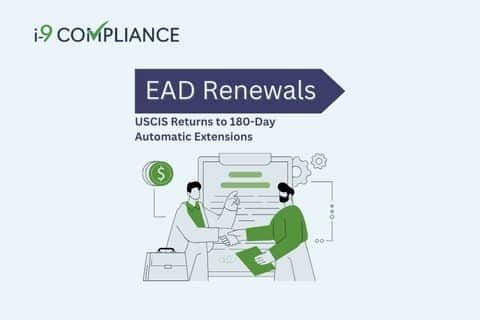USCIS Returns to 180-Day Automatic Extensions for EAD Renewals

November 15, 2023
The U.S. Citizenship and Immigration Services (USCIS) announced the end of the extended timeframe for automatically extending employment authorization documents (EADs). The USCIS also included reminders about future automatic extensions. According to the USCIS, future beneficiaries will continue receiving these extensions within the original timeframe.
Under the now-closed timeframe, eligible renewal applicants would receive 540-day automatic extensions to their EADs. This temporary final rule went into effect on May 4, 2022. The agency hoped the temporary rule would ease its struggles with the immense backlog. The Director of the USCIS, Ur M. Jaddou, also commented on the backlog. According to the Director,
“As USCIS works to address pending EAD caseloads, the agency has determined that the current 180-day automatic extension for employment authorization is currently insufficient. This temporary rule will provide those non-citizens otherwise eligible for the automatic extension an opportunity to maintain employment and provide critical support for their families while avoiding further disruption for U.S. employers.”
The temporary final rule had a cutoff date of October 27, 2023, which recently passed. Furthermore, the USCIS has reminded those who filed before this date that the change is not retroactive. As such, the previously issued 540-day automatic extensions will remain in effect.
The agency is considering a new regulatory action similar to the 2022 temporary final rule. This consideration comes after the agency took many steps to improve the EAD application and renewal processes. Until it takes such an action, the USCIS will return to issuing 180-day extensions to eligible renewal applicants. The USCIS also reminds applicants to file an Application for Employment Authorization (Form I-765) on time to become eligible.
The announcement also clarified details for those who received a 540-day extension under the previous policy. The extension will end either on the expiration of the extension period or after receiving a final decision on the renewal application, whichever happens first. However, those who received an EAD on or after September 27, 2023, could see an extended validity period.
The USCIS also recently updated its Policy Manual. It increased the maximum EAD validity period for certain non-citizens in this update. This update also affects admitted or paroled refugees, applicants for adjustment of status, individuals granted asylum, recipients of withholding of removal, and applicants for suspension of deportation or cancellation of removal.
For employers, it is crucial to keep these changes to employment authorization in mind to keep Form I-9s accurate and current. The best way to ensure compliance with the employment eligibility verification process is to use an electronic I-9 management tool. This tool can guide employers through the verification process, provide digital storage of forms and documentation, and send reminders when action is required to maintain compliance.
Automate your employment eligibility verification today with the ensured compliance of I-9 Compliance.